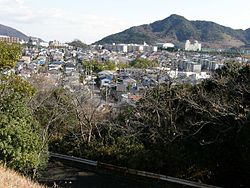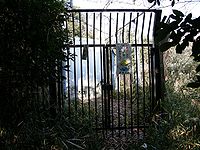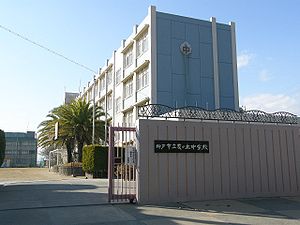- Seito Sakakibara
-
Seito Sakakibara Background information Also known as Boy A
OnibaraBorn Kobe, Hyogo, Japan Killings Number of victims: 2 Span of killings March 16, 1997–May 27, 1997 Country Japan Date apprehended June 28, 1997 Seito Sakakibara (酒鬼薔薇 聖斗 Sakakibara Seito) is the alias of a then-14-year-old student from Kobe, Japan who murdered an 11-year-old boy and a 10-year-old girl between March and May 1997. Also identified as Onibara (due to an error in reporting by the Japanese media), his real name has not been released to the press as per Japanese legal procedures prohibiting the identification of juvenile offenders, and he is officially referred to as "Boy A" in Japanese legal documentation.
Contents
Early life
Sakakibara began carrying cutting weapons while still in elementary school, writing in his diary that "I can ease my irritation when I'm holding a survival knife or spinning scissors like a pistol." At age 12, he exhibited extreme cruelty to animals, lining up a row of frogs in a street and riding over them with his bicycle, as well as mutilating cats and decapitating pigeons.
After the March 16 attack, he wrote in his diary: "I carried out sacred experiments today to confirm how fragile human beings are... I brought the hammer down, when the girl turned to face me. I think I hit her a few times but I was too excited to remember." The following week, on March 23, he added: "This morning my mom told me, 'Poor girl. The girl attacked seems to have died.' There is no sign of my being caught... I thank you, "Bamoidōkishin", for this... Please continue to protect me."
The murders
On May 27, 1997, the head of Jun Hase (土師 淳 Hase Jun, ca. 1986 - May 27, 1997), a special education pupil at Tainohata Elementary School, was found in front of the school gate hours before pupils arrived for classes. Hase had been beheaded with a hand saw, with further mutilations being done before being left in front of the school, for students to discover when they arrived in the morning.[1] A note, written in red pen, was found stuffed in his mouth, identifying the killer as "Sakakibara." The note read:
"This is the beginning of the game... You police guys stop me if you can... I desperately want to see people die, it is a thrill for me to commit murder. A bloody judgment is needed for my years of great bitterness."
Additionally, some English was on the note as well: "shooll kill [sic]".
Police commented that the style of Hase's killing and the note was reminiscent of that of the Zodiac murders in the San Francisco area during the late 1960s.
Other letters and "Onibara"
 Left: the site of the May 1997 Sakakibara murder. Right: the letter sent to a newspaper, claiming responsibility for the killing.
Left: the site of the May 1997 Sakakibara murder. Right: the letter sent to a newspaper, claiming responsibility for the killing.On June 6, a letter was sent to the newspaper Kobe Shinbun, in which Sakakibara claimed responsibility for the slaying and decapitation of Jun Hase, and threatened that more killings would follow. This second letter, delivered in a brown envelope postmarked June 3, had no return address or name. Enclosed was a three-page, 1400-word letter, also written in red ink, which included a six-character name that can be pronounced as "Sakakibara Seito." The same characters, which mean alcohol, devil, rose, saint and fight, were used in the first message that was inserted into the boy's mouth.
Beginning with the phrase "Now, it's the beginning of a game," the letter stated that "I am putting my life at stake for the sake of this game... If I'm caught, I'll probably be hanged... police should be angrier and more tenacious in pursuing me.... It's only when I kill that I am liberated from the constant hatred that I suffer and that I am able to attain peace. It is only when I give pain to people that I can ease my own pain." The letter also lashed out against the Japanese educational system, calling it "compulsory education that formed me, an invisible person."[2]
In the initial panic, the Japanese media misreported the name as "Onibara" - Demon's Rose, though the killer insisted it was as he gave it. Infuriated by the mixup, Sakakibara later wrote to the station, "From now on, if you misread my name or spoil my mood I will kill three vegetables a week.... If you think I can only kill children you are greatly mistaken."
A 14-year-old junior high school student was arrested as a suspect in the Hase murder on June 28. Shortly after his arrest, "Boy A" also confessed to the murder of 10-year-old Ayaka Yamashita (山下彩花 Yamashita Ayaka) on March 16, as well as the assaults of three other girls on and around that same date.
Impact on the media
At the murder scenes some[citation needed] have alleged a symbol exactly like the Zodiac Killer's was found. After the murders, Japanese politician Shizuka Kamei called for restricting objectionable content, stating, "Movies lacking any literary or educational merit made for just showing cruel scenes... Adults should be blamed for this," and that "[t]he incident gives adults the chance to rethink the policy of self-imposed restrictions on these films and whether they should allow them just because they are profitable."[3]
Aftermath
In 2000, the Diet lowered the age for criminal responsibility from 16 to 14. However, in the wake of the June 1, 2004 murder of Satomi Mitarai by 11-year-old "Girl A" (Sasebo slashing), there has been some discussion for the need for further revision.
On March 11, 2004, in an unprecedented act, the Japanese Ministry of Justice announced that Sakakibara, 21 at the time, was being released on a provisional basis, with a full release to follow on January 1, 2005.[4] Critics have charged that since the government had taken the unusual step of notifying the public, that Sakakibara was likely not fit for release and should be transferred to prison. In the wake of the Sasebo slashing, three months later, this criticism was exacerbated.
Due to the seriousness of the crimes and the fact that they had been committed by a minor, his name and new residence to this day remain a highly-guarded secret. Yet, his real name has been circulated on the internet since June 29, 1997, according to journalist Fumihiko Takayama.
Controversy
A number of people, including Shōjirō Gotō (a lawyer who dealt with many false accusation cases), Hidehiko Kumagai[citation needed] and Nobuyoshi Iwata (former principal of the junior high school that Boy A attended), insist that Boy A was wrongfully accused and point out contradictions in the statements of the investigating authorities.
See also
References
- ^ "Kobe murder". Weekly Bunshun. July 24, 1997.
- ^ "Kobe School Killer". http://www.crimezzz.net/serialkillers/K/KOBE_school_killer.htm. Retrieved 2008-09-19.
- ^ Herskovitz, Jon (July 6, 1997). "Murder keys Japan vid crackdown". Variety. http://www.variety.com/article/VR1116677377?categoryid=13&cs=1.
- ^ "Kobe killer set free". The Japan Times. 2004-03-11. http://search.japantimes.co.jp/cgi-bin/nn20040311a1.html. Retrieved 2011-02-03.
- Picture of the scene of the crime You Tube
- Sympathy for the devil Al-Ahram Weekly, March 18, 1999
- Murder keys Japan vid crackdown Variety.com, July 7, 1999
- 神戸事件の真相を究明する会 The meeting which studies the truth of Kobe case
Categories:- 1983 births
- Living people
- Murder in 1997
- People from Kobe
- Japanese murderers of children
- Murder committed by minors
Wikimedia Foundation. 2010.




